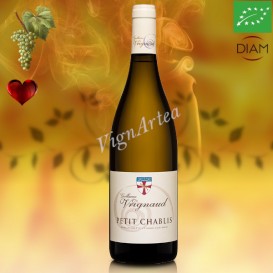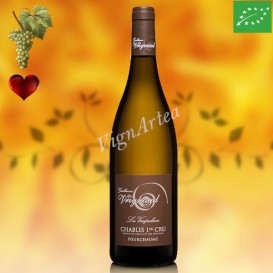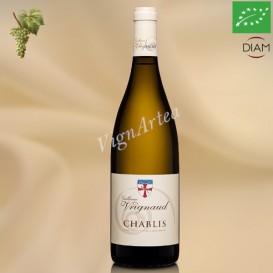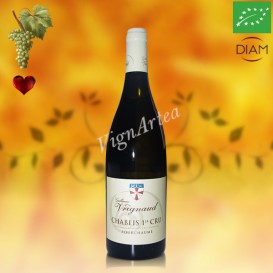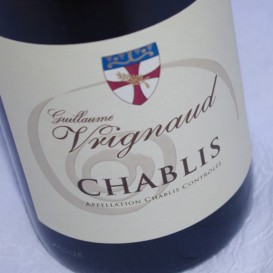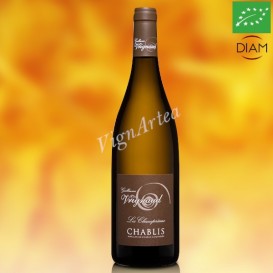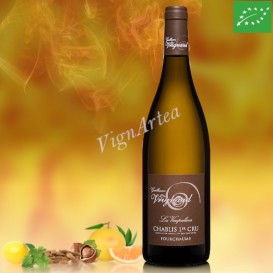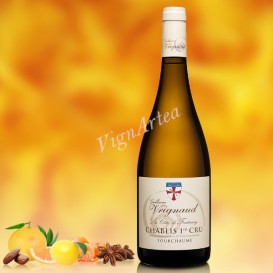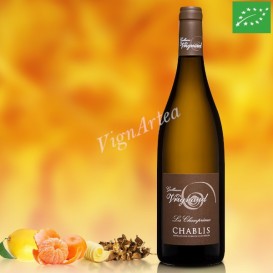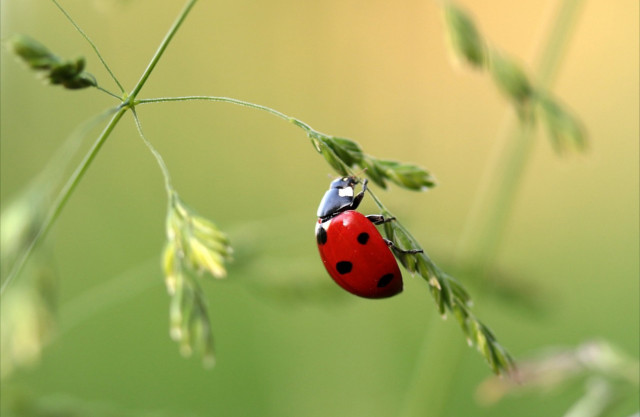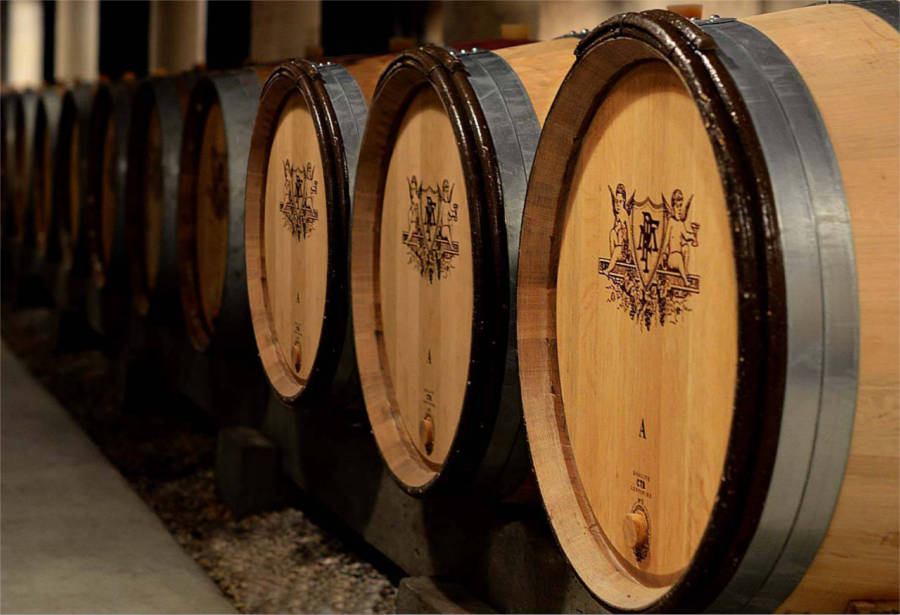Domaine VRIGNAUD

CHABLIS 24 ha CERTIFIED ORGANIC AGRICULTURE WINEMAKER: Guillaume VRIGNAUD
ESTATE HISTORY
Guillaume VRIGNAUD is running, since 1999, the family estate located in Fontenay-près-Chablis, in the heart of the Chablis Premiers Crus Fourchaume. The vineyard of 24 ha is divided between the different designations Petit Chablis (2 ha on the place "Chemin des Chaumes"), Chablis (14 ha on the places "Champreaux" (3 ha), "Bralée", "Chemin des chaumes", "Sur l’Etang", "les Usages", "Chasse Loup"), Chablis 1er Cru (4 ha in "Fourchaume", and 27 ares in "Mont de Milieu" and 1.23 ha in "Côtes de Fontenay"), and Chablis Grand Cru. The oldest vines were planted in 1955, and their grapes are used to elaborate the cuvée Fourchaume 1er cru "Côtes de Fontenay".
TERROIR
The soils of the Chablis region and its surroundings were formed mainly between the Upper Oxfordian (beginning of the Upper Jurassic, 161 My ago) and the Albian (end of the Lower Cretaceous, 99.6 My ago). Between the Upper Oxfordian and the Lower Kimmeridgian (-161 Mya to -152 Mya), the Chablis region is covered by a warm and relatively shallow sea.
In the middle and upper Kimmeridgian (-152 to -150 Mya), the sedimentation become rhythmic, clayey and calcareous, facilitating the development of the Exogyra Virgula, some small oysters whose fossilised shells are now found in the rock.
In the Portlandian (-149 to -142 Mya), after a few recurrences, the most clayey sequences disappear, the sedimentation becomes carbonate and continues until the general regression of the waters.
The vineyard of the VRIGNAUD estate is divided into two terroirs:
- The limestone and marl of the middle and upper Kimmeridgian with an average thickness of 80 metres. They alternate between banks of limestone rich in small oyster fossils, the Exogyra Virgula, and grey marl. The slopes are generally the gentlest, with the exception of certain plots where they are steeper,
- The limestones of the Barrois, Portlandian stage, which overhang the kimmeridgian slopes, and on which the vine is not very present: the very hard Portlandian limestones are however separated by marly banks of about fifty meters thick, which makes them able to accomodate the vine by place.
WINEGROWING & WINEMAKING
Totally invested in a healthy approach, Guillaume gradually converts his vineyard to the organic farming, year after year. A long conversion, started in 2012, which is accompanied by a significant yield loss but in favor of a much higher grape quality. In 2014, the entire vineyard is certified "Organic Farming" with the exception of the small plot "Mont de Milieu" of the Chablis 1er Cru designation.
Winemaking has been recently done with native yeasts. The alcoholic fermentation takes place in stainless steel tanks, and it is systematically followed by the malolactic fermentation to stabilize the wine. The ageing is usually done on fine lees to give the wines more finesse and roundness.
At the tasting, the wines of this estate offer a wide range of aromas, all of them show a well-marked identity according to the place they are made of, sometimes round and smooth, sometimes lively and mineral: purity for a lot of pleasure.
-
PETIT CHABLIS 2023 (Domaine Vrignaud)
17,95 € OUT OF STOCK!OUT OF STOCK!BURGUNDY - AOP PETIT CHABLIS - DRY WHITE WINE
Grape variety: Chardonnay (100%)
Organic Native yeasts DIAM 5® cork stopper
Lees ageing in stainless steel tanks for 8 monthsFresh - Mineral
- Nose: fresh and fruity. Aromas of lemon with a hint of white peach and a hint of white pepper.
- Palate: tonic and very fresh. Mineral finish.
- Tasting date: Mai 2025.
- OUR OPINION: a very thirst-quenching vintage, mineral and nicely chiselled. ❤️❤️
- Nose: fresh and fruity. Aromas of lemon with a hint of white peach and a hint of white pepper.
-
CHABLIS 1er Cru Fourchaume Les Vaupulans 2022 (Domaine Vrignaud)
37,80 € In stock!BURGUNDY - AOP CHABLIS 1ER CRU - DRY WHITE WINE
Grape variety: Chardonnay (100%)
Organic wine Native yeasts DIAM 5® cork stopper
Lees ageing in oak barrels for 12 monthsTasty - Fresh - Elegant
- Nose: fresh, elegant and complex. Slight hint of minerality, notes of lemon, white grapefruit, fennel. A touch of smoked notes.
- Palate: round and fragrant, sustained by a fine acidity. Long lemony finish.
- Tasting date: May 2025.
- OUR OPINION: perfect! A vintage of great elegance, tasty and fresh, with a hint of minerality that makes it extremely thirst-quenching. ❤️❤️
- Nose: fresh, elegant and complex. Slight hint of minerality, notes of lemon, white grapefruit, fennel. A touch of smoked notes.
-
CHABLIS 2022 (Domaine Vrignaud)
22,99 € In stock!BURGUNDY - AOP CHABLIS - DRY WHITE WINE
Grape variety: Chardonnay (100%)
Organic wine Native yeasts DIAM 5® cork stopper
Lees ageing in stainless steel tanks for 8 monthsAmple - Flavoursome - Fruity
- Nose: intense. Light creamy notes, aromas of lemon and white grapefruit, with a hint of fennel.
- Palate: supple texture underpinned by fine tension. Long-lasting aromas.
- Tasting date: September 2024.
- OUR OPINION: an attractive, rather full-bodied vintage, with generous fruit and a well-balanced palate.
- Nose: intense. Light creamy notes, aromas of lemon and white grapefruit, with a hint of fennel.
-
CHABLIS 1er Cru Fourchaume 2022 (Domaine Vrignaud)
35,60 € In stock!BURGUNDY - AOP CHABLIS 1er Cru - WHITE WINE
Grape variety: Chardonnay (100%)
Organic Native yeasts DIAM 5® cork stopper
Lees ageing in stainless steel tanks for 12 monthsFresh - Fine - Mineral
- Nose: mineral and fresh. Citrus notes with a hint of white peach and aniseed.
- Palate: supple, delicate attack, underlined by fine tension on the palate.
- Tasting date: October 2024.
- OUR OPINION: a very fine vintage with a delicate, mineral profile. The perfectly measured tension on the palate gives it finesse and elegance.
- Nose: mineral and fresh. Citrus notes with a hint of white peach and aniseed.
-
CHABLIS 2021 (Domaine Vrignaud)
22,99 € In stock!BURGUNDY - AOP CHABLIS - DRY WHITE WINE
Grape variety: Chardonnay (100%)
Organic wine Native yeasts
Lees ageing in stainless steel tanks for 8 months
DIAM 5® cork stopper- Nose: tasty and intense. Aromas of yellow peach and candied orange, with a touch of white flowers and light creamy notes.
- Palate: supple attack, tasty and fruity juice. Slightly saline finish.
Tasting date: December 2022.
OUR OPINION: a tasty and complex vintage, beautiful freshness.
Other vintage available/span>:
-
CHABLIS Les Champréaux 2021 (Domaine Vrignaud)
23,20 € In stock!BURGUNDY - AOP CHABLIS - DRY WHITE WINE
Grape variety: Chardonnay (100%)
Organic wine Native yeasts DIAM 5® cork stopper
Lees ageing in oak barrels for 10 months- Nose: intense. White flowers, vine peaches and lychee, pink grapefruit.
- Palate: supple and tasty, fresh and with a nice tension. Lime finish.
- Tasting date: January 2023.
- OUR OPINION: full and very fragrant vintage. It seduces by its freshness and its tonicity.
- Nose: intense. White flowers, vine peaches and lychee, pink grapefruit.
-
CHABLIS 1er Cru Mont de Milieu 2019 (Domaine Vrignaud)
31,99 € In stock!BURGUNDY - AOP CHABLIS 1ER CRU - DRY WHITE WINE
Grape variety: Chardonnay (100%)
Organic wine Native yeasts DIAM 5® cork stopper
Lees ageing in stainless steel tanks for 12 months- Nose: tasty and slightly toasted. Notes of white flowers, pink grapefruit, lime and a hint of aniseed.
- Palate: fresh, tonic and enveloping. Long lemony and delicately aniseed finish.
- Tasting date: January 2022.
- OUR OPINION: a fresh and floral wine!
- Nose: tasty and slightly toasted. Notes of white flowers, pink grapefruit, lime and a hint of aniseed.
-
CHABLIS 1er Cru Fourchaume Les Vaupulans 2015 (Domaine Vrignaud)
29,99 € In stock!BURGUNDY - AOP CHABLIS 1ER CRU - DRY WHITE WINE
Grape variety: Chardonnay (100%)
Organic wine Native yeasts DIAM 5® cork stopper
Lees ageing in oak barrels for 12 months- Color : Beautiful pale colour.
- Nose: Smoky and slightly toasted. Aromas of hazelnut, lemon, grilled almond, white grapefruit with a hint of coriander.
- Palate: elegant, perfumed, round and saline.
- Tasting date: October 2021.
- OUR OPINION: a wine of great finesse!
- Color : Beautiful pale colour.
-
CHABLIS 1er Cru Les Côtes de Fontenay 2015 (Domaine Vrignaud)
36,60 € In stock!BURGUNDY - AOP CHABLIS - DRY WHITE WINE
Grape variety: Chardonnay (100%)
Selected yeasts DIAM 5® cork stopper
Lees ageing stainless steel tanks for 10 months- Nose: very complex. Scents of aniseed, grapefruit and lemon, with a hint of tangerine and almond.
- Palate: supple attack with a delicate and aromatic touch, and a finish evoking liquorice.
- Tasting date: November 2021.
- OUR OPINION: very nice vintage, charming and complex.
- Nose: very complex. Scents of aniseed, grapefruit and lemon, with a hint of tangerine and almond.
-
CHABLIS Les Champréaux 2019 (Domaine Vrignaud)
22,80 € In stock!BURGUNDY - AOP CHABLIS - DRY WHITE WINE
Grape variety: Chardonnay (100%)
Organic wine Native yeasts DIAM 5® cork stopper
Lees ageing in oak barrels for 10 months- Nose: delicate and very fine. Citrus notes dominated by lemon and tangerine, accompanied by pleasant scents of mousseron with a hint of butter.
- Palate: pleasant with its roundness and its beautiful acidity which invigorates the juice.
- Tasting date: October 2021.
- OUR OPINION: a very tasty and gourmet Chablis!
- Nose: delicate and very fine. Citrus notes dominated by lemon and tangerine, accompanied by pleasant scents of mousseron with a hint of butter.
- 1
- 2

